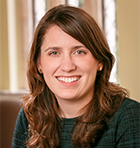Big data makes a big impact at UR
Research & Innovation
In today’s world, there’s an abundance of data. Whether it’s the number of steps logged on a Fitbit, weather trends over time, or 9,000-year-old DNA, there’s a tremendous amount of data that can reveal important insights — if you know how to analyze it.
At UR, faculty and students from across the disciplinary spectrum are using data analytics and computational technology to better understand the past and present, while developing skills and expertise that will be critical to the future.
Steph Spera, assistant professor of geography and the environment, uses data science to study the links between deforestation and climate change in the Amazon. Based on satellite data from the cloud-based Google Earth Engine, Spera can map the effects of road building projects on ecosystems or experiment with climate models and algorithms to predict how clearing land could affect rainfall.
“My research has shown farmers might reach a tipping point where they clear so much land for farming that they affect the hydrological cycle and won’t get the rain they need,” Spera said. “They're already increasing night temperatures, which is really bad for corn.”
Data analysis makes a process faster in a way that can be hard for an individual or team to do.

But data analytics isn’t just for math and science, or composed of only numbers and statistics.
Photos from the Farm Security Administration and Office of War Information have long provided a glimpse at life during the Great Depression and World War II. Lauren Tilton, assistant professor of digital humanities, thought computer vision would help her see the images in a new light. Her team analyzed 170,000 photographs, identifying image features such as people, places, objects, aesthetics, and the use of color versus black and white. The end result is Photogrammar, a public dashboard that allows users to search for photos by those characteristics, and encourages questions about how we use and interpret imagery.
“Data analysis makes a process faster or more iterative in a way that can be hard for an individual or team to do,” Tilton said. “A big part of what we think about is how might we scale up our research through the affordances of computational [technology] that allows us to open up new and different questions about the past and the present.”
With such a vast quantity of information to process, students often play a hands-on role in organizing, and analyzing data. At a larger research university, it’s work that might have gone to a graduate student — not undergraduates.
Melinda Yang, assistant professor of biology, currently has six research assistants helping her use ancient DNA to study the populations and movements of humans in East Asia, and compare their DNA to present-day humans.
She’s training some students to use the programming language Python, which will better equip her students to access the large datasets Yang uses. They can eventually develop and analyze simulations about population data.
By playing a hands-on role in projects like these, students gain analytical skills that are crucial in any field and, in some cases, to careers that don’t even exist yet.
The need for these skills is becoming so evident that liberal arts universities across the country are launching programs — but most are starting from ground zero. At UR, faculty have been doing computational and data-related work for years, positioning the University to become a leader in the space.
A committee of faculty from across the university is focusing on how to bring this work into a unified focus. They’re working to identify necessary resources to support existing teaching and research, such as a shared group of connected computers that can process large quantities of data for faculty and their student researchers. The committee is also exploring new courses and teaching methodologies and potential majors and minors.
Faculty are also considering how to integrate the analytical nature of data science with the broad-based thinking of the liberal arts. As the volume of data continues to expand dramatically, it will be important to have people who consider the ethics of information.
In her Data and Society class, Tilton is raising these questions and encouraging students to think about the cultural, political, social and economic considerations that shape how data is created and categorized.
“My approach is that we be thoughtful and critical about what data is and what we can do with it,” she said. “If we aren’t, we get a lot of problematic decision-making — collecting, analyzing, or releasing data that is deeply shaping people's daily lives, and not always for the better.”

